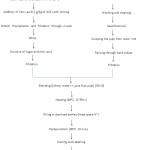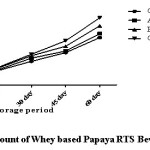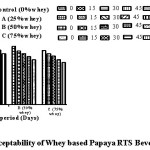Introduction
Fruits and vegetables embrace an important status among the health foods as they provide significant amount of nutrients, especially vitamins, minerals, fiber sugars and antioxidants as well as it’s refreshing and thirst quenching behavior1. However, due to highly perishable nature and short shelf life of fruits and vegetables, immediate processing into preserved products becomes essential to avoid post-harvest losses. India contributes 42% of world production from 30% of the global area under papaya cultivation and is largest producer according to FAO report (2012). Papaya accounts for 6.6% of total crop and covers only 19% of the total area under fruit cultivation in India.2 So Papaya was selected for preparation of fruit drink due to its reasonable price, easy availability and high nutritive value. Papaya is also known as common man’s fruit and belongs to Caricaceae family. Papaya possess attractive colour, luscious taste, rich source of minerals like potassium and magnesium, nutrients such as carotenoids, vitamins C, E & flavonoids which acts as antioxidants; vitamins B, folate, pantothenic acid; and fiber.3 Nutritionally, almost fruits/fruit drinks are devoid of protein, which is an important for body build, repair and immunity.
Whey is a watery liquid by-product of dairy industry during the preparation of channa, paneer, cheese and casein. World whey production is 180 to 190 × 106 tonnes/year with an annual increment of 1-2% and only 50% of whey is utilized/processed.4 Whey contains 45-50% total milk solids, 70% milk sugar (lactose), 20% milk proteins and 70-90% milk minerals and almost all the water soluble vitamins originally present in milk5 So, Whey disposal becomes a serious environmental pollutant being loaded with high amount of organic matter. Whey possesses preventive and curative elements responsible for treatment of ailments such as arthritis, anemia and liver complaints.6 Fruit and dairy/dairy waste based products are attaining considerable attention due to delicious taste, increased energy value and high nutritional value and market for such food products has incredible potential.7 Whey based fruits beverages are more suitable for health as compared to other drinks.8 Production of nourishing pleasant whey based fruit RTS beverages is one of the most promising trends in the utilization of dairy waste, whey. The present study was planned to prepare papaya RTS by incorporating different level of whey and study its storage behavior.
Material and method
Sample Procurement and Preparation
Toned milk and papaya were procured fresh from local market. The whey was obtained using toned milk by simple acid coagulation methods. The hot milk in stainless steel vessel was acidified by simple acid (2% citric acid) coagulation method. Mature and fully ripened papaya fruits were selected. Pulping of papaya was done with method of Lal et.al.,9 and stored at 4 ± 1°C until use. The RTS beverage was prepared by using whey, water, pulp, sugar and citric acid as per FPO specification.10 Different variants of beverages were formulated using three different levels of whey i.e. 25%, 50%, and 75% by replacing water. The prepared RTS was packed in sterilized bottle (capacity 200 ml) leaving ½” head space and capped air tight. The steps involved in the preparation of whey based papaya RTS are given in Figure 1. After in-bottle pasteurization (80 ℃ for 10 min) and cooling, RTS was stored at refrigeration temperature for 60 days.
 |
Figure 1: Flow chart for Whey based Papaya RTS beverage preparation Click here to View figure |
Physicochemical analysis
TSS (using Abbe’s hand refratometer), titratable acidity, total and reducing sugars, ascorbic acid11 and microbiological load (Total plate count) of RTS was determined periodically (15 days) over the period of 3 months.
Sensory Evaluation
The fresh and stored beverage samples were organoleptically evaluated by 10 semi-trained members from Department of Food Technology and Nutrition, Lovely Professional University, Jalandhar, India, using Hedonic scale ranging from 1-9 for lowest to highest for color, flavor, taste, and overall acceptability.12
Statistical analysis
Data obtained from the physico-chemical, microbiological and sensory attributes of papaya whey RTS were analyzed by using Graph Pad Prism (La Jolla, CA, USA) (version 5.01) software. Results are expressed as means ± SD. Differences between the means were tested for statistical significance using a 2-way ANOVA and followed by Bonferroni post-hoc test. The significance level was set at 5% (P<0.05) for all calculations.13
Results and Discussion
Effect of storage on Physico-chemical characteristics of Whey based Papaya RTS beverage
The changes noted in the physiochemical constituents are given in Table 1.
Total soluble solids
With complete replacement of water with whey, TSS was found to increase from 15.20±0.35 to 18.15±0.18. This is due to water replacement with whey as whey contains water, milk solids, lactose, proteins and minerals. On storage, TSS of beverage was enhanced during storage period for all samples (Table 1). However, retention or slight increase in TSS content of juice is desirable for preservation of good juice quality during storage.14 This small increment in TSS might be due to polysaccharides hydrolysis into monosaccharide and soluble disaccharides.15
Acidity
A gradual increase in the acidity of RTS beverage was observed during storage. The average initial acidity of papaya RTS was 0.30±0.3 and increased to 0.34±0.18%. Similar results has been reported by Saravana et al.16 in whey based jack fruit RTS; Panghal et al.,17 in whey based strawberry RTS. During storage, degradation of sugar into carboxyl acids, lactose into lactic acid or pectin into pectinic acid is responsible for slight increase in titratable acidity.18 Whey protein might get converted into amino acids which accounts for small increase in titratable acidity.19
Table 1: Effect of Storage on Physico-chemical characteristics of Whey based Papaya RTS Beverage
|
Level (%) of water replacement with whey |
Storage period (days) | TSS(o Brix) | Acidity(% ) | Reducing Sugar (g %) | Total Sugar(g %) |
Ascorbic acid (mg %) |
| Control (0 % whey) | 0 | 14.98±0.24 | 0.30±0.3 | 5.34±0.01 | 13.80±0.38 | 5.60±0.04 |
| 15 | 15.09±0.16 | 0.30±0.2 | 5.36±0.01 | 13.98±0.45 | 5.58±0.03 | |
| 30 | 15.12±0.18 | 0.32±0.15 | 5.36±0.04 | 14.06±0.51 | 5.54±0.03 | |
| 45 | 15.18±0.22 | 0.32±0.16 | 5.38±0.02 | 14.14±0.48 | 5.52±0.04 | |
| 60 | 15.20±0.35 | 0.34±0.18 | 5.40±0.01 | 14.23±0.55 | 5.51±0.02 | |
| A ( 25% whey) | 0 | 15.05±0.18 | 0.30±0.11 | 5.37±0.01 | 14.06±0.46 | 5.60±0.02 |
| 15 | 15.22±0.09 | 0.32±0.09 | 5.37±0.02 | 14.14±0.39 | 5.59±0.02 | |
| 30 | 15.65±0.21 | 0.32±0.13 | 5.37±0.02 | 14.22±0.43 | 5.57±0.05 | |
| 45 | 15.79±0.17 | 0.33±0.12 | 5.39±0.03 | 14.30±0.51 | 5.56±0.09 | |
| 60 | 15.85 ±0.19 | 0.33±0.13 | 5.42±0.03 | 14.38±0.42 | 5.54±0.03 | |
| B (50% whey) | 0 | 15.88±0.13 | 0.30±0.17 | 5.40±0.03 | 14.09±0.13 | 5.60±0.05 |
| 15 | 16.05±0.17 | 0.32±0.11 | 5.42±0.02 | 14.19±0.26 | 5.60±0.01 | |
| 30 | 16.38±0.15 | 0.34±0.08 | 5.45±0.05 | 14.22±0.19 | 5.58±0.06 | |
| 45 | 16.95±0.19 | 0.34±0.12 | 5.46±0.02 | 14.37±0.24 | 5.55±0.05 | |
| 60 | 17.25±0.21 | 0.36±0.13 | 5.48±0.03 | 14.49±0.44 | 5.52±0.02 | |
| C(100% whey) | 0 | 17.03±0.13 | 0.30±0.12 | 5.45±0.05 | 14.30±0.22 | 5.60±0.04 |
| 15 | 17.25±0.16 | 0.32±0.16 | 5.46±0.04 | 14.48±0.32 | 5.58±0.03 | |
| 30 | 17.78±0.08 | 0.34±0.19 | 5.46±0.03 | 14.62±0.17 | 5.57±0.03 | |
| 45 | 18.02±0.12 | 0.35±0.12 | 5.49±0.03 | 14.78±0.24 | 5.55±0.04 | |
| 60 | 18.15±0.18 | 0.37±0.13 | 5.52±0.02 | 14.93±0.18 | 5.53±0.02 |
Total and reducing sugars
Sugars were present in form of fruit sugar, lactose and added sugar in all formulations. So with increase in level of whey incorporation from 0 to 75%, total (13.80±0.38, 14.06±0.46 , 14.09±0.13 , 14.30±0.22 ) and reducing sugars (5.34±0.01, 5.37±0.01, 5.40±0.03, 5.45±0.05) were increased (Table 1). The reducing sugars and total sugars increased during storage of 60 days at refrigeration temperature for all the treatments, this might be due to hydrolysis of polysaccharides like starch, cellulose, pectin, etc. and conversion into simple sugars (glucose, fructose). However, rise in total sugars was non-significant and similar results have been reported by,20 Krishnaveni et al.,21 in Jack fruit RTS, Kausar et al.,22 in cucumber–melon functional drink, Majumdar et al.,23 in bottled gourd–basil leave juice.
Ascorbic Acid
Ascorbic acid also did not show any significant degradation after storage at refrigeration temperature (Table 1). Ascorbic acid content decreases with the progression of storage time which might be due to oxidation reaction by residual oxygen, followed by decomposition which might have been accelerated due to the storage time. These results are in well coherence with Saravana et al.16; Ibrahim.24
Effect of storage on Microbial quality of Whey based Papaya RTS beverage
The microbial load of RTS was analyzed periodically during storage (Figure 2) and it showed that there was negligible increase in microbial load and beverage was safe for consumption. Total plate count was comparatively higher as level of whey addition increased due to more availability of nutrients in whey (Figure 2). Whey contains lactose sugar and proteins favorable for microorganism growth. Similar results have been reported by Sakhale et al.,25 for whey-based RTS from mango.
 |
Figure 2. Total plate count of Whey based Papaya RTS Beverage during storage.Effect of storage on Organoleptic Evaluation of RTS beverage Click here to View figure |
Effect of storage on Organoleptic Evaluation of RTS beverage
Beverage formulated with different whey combinations (0, 25, 50, 100%) were evaluated at regular intervals for various sensorial attributes by using 9 point hedonic scale. The sensory scores for various parameters (color, flavor, taste and overall acceptability) are presented in Table 2.
Table 2: Effect of Storage on Organoleptic Quality of Whey based Papaya RTS Beverage
|
Level (%) of water replacement with whey |
Storage period (days) | Color | Flavor | Taste |
Overall acceptability |
| Control (0 % whey) | 0 | 9.00±0.17 | 9.00±0.21 | 8.99±0.13 | 9.00± 0.43 |
| 15 | 8.82±0.11 | 8.85±0.19 | 8.78±0.25 | 8.82±0.36 | |
| 30 | 8.69±0.19 | 8.68±0.08 | 8.06±0.33 | 8.48±0.29 | |
| 45 | 8.53±0.24 | 8.51±0.31 | 7.54±0.16 | 8.19±0.22 | |
| 60 | 8.29±0.13 | 8.26±0.25 | 7.06±0.22 | 7.87±0.39 | |
| A ( 25% whey) | 0 | 8.13±0.09 | 8.83±0.18 | 8.82±0.18 | 8.59±0.21 |
| 15 | 7.98±0.11 | 8.45±0.24 | 8.58± 0.37 | 8.34±0.19 | |
| 30 | 7.59±0.13 | 8.16±0.16 | 8.12±0.22 | 7.96±0.24 | |
| 45 | 7.26±0.26 | 7.92±0.11 | 7.89±0.29 | 7.69±0.33 | |
| 60 | 7.00± 0.34 | 7.13±0.21 | 7.45±0.13 | 7.19±0.18 | |
| B (50% whey) | 0 | 7.92±0.27 | 8.12±0.25 | 8.68±0.17 | 8.24±0.13 |
| 15 | 7.02±0.15 | 7.59±0.18 | 8.08±0.23 | 7.56±0.16 | |
| 30 | 6.78±0.13 | 7.16±0.22 | 7.68±0.28 | 7.21±0.41 | |
| 45 | 6.39±0.08 | 6.89± 0.53 | 7.05±0.31 | 6.78±0.13 | |
| 60 | 6.05±0.18 | 6.43±0.23 | 6.49±0.18 | 6.32±0.39 | |
| C(100% whey) | 0 | 7.16±0.13 | 7.76±0.19 | 8.18±0.27 | 7.65± 0.43 |
| 15 | 6.85±0.24 | 7.15±0.36 | 7.53±0.34 | 7.18±0.31 | |
| 30 | 6.54±0.17 | 6.83±0.13 | 7.17±0.21 | 6.85±0.24 | |
| 45 | 6.13±0.24 | 6.54± 0.28 | 6.42±0.18 | 6.36±0.13 | |
| 60 | 5.82±0.35 | 6.03±0.17 | 6.01±0.38 | 5.95±0.19 |
On increasing whey level, all sensory parameters were decreased. Color values decreased from 9.00±0.17 to 7.16±0.13. Flavor and taste scores were also declined to 7.76±0.19 and 8.18±0.27 respectively. Thus, overall acceptability decreased from 9.00± 0.43 to 7.65± 0.43 with increase of whey level from 0 to 100%. Addition of whey is responsible for dull whitish appearance of beverage, reduced flavor, taste and thus overall acceptability. However, beverage with 25% whey was quite comparable to control sample and was found acceptable as compared to other whey incorporated beverages (Figure 3).
 |
Figure 3: Overall acceptability of Whey based Papaya RTS Beverage during storage Click here to View figure |
During storage, overall acceptability declined for all treatments, however, quality degradation was higher in case of high whey level. Whey accounts for more microbial growth, reduced acidity and off flavor. So, during storage there is immense loss of color due to browning, increase in acidity changes taste and flavor of beverage. Thus overall acceptability of the samples decreased during storage (Table 2). Similar results have been reported by Sakhale et.al.,25 for whey-based RTS from mango.
Conclusion
The study revealed that whey can be a suitable ingredient for development of whey based healthy beverages. However, addition of whey was found acceptable only up to 25% in terms of nutritional information and consumer acceptability. Distinct papaya flavor is capable to mask unpleasant taste and flavor of whey. This approach can be suitable for proper utilization of dairy waste whey and beneficial for papaya value addition.
Acknowledgements
This research was supported by Lovely Professional University, Punjab. We thank our colleagues from Lovely Professional University and Chaudhary Devi Lal University, Haryana who provided insight and expertise that greatly assisted the research.
Reference
- Yadav DN, Vishwakarma RK, Borad S, Bansal S, Jaiswal AK, Sharma M. Development of protein fortified mango based ready-to-serve beverage. Journal of Food Science and Technology; 2016;53(10):3844-52.
CrossRef - Sharma SK, Mitra SK, Saran S. Papaya production in India-history, present status and future prospects. InXXIX International Horticultural Congress on Horticulture: Sustaining Lives, Livelihoods and Landscapes (IHC2014): IV 1111.2014;87-94.
- Ramachandran P, Nagarajan S. Quality Characteristics, Nutraceutical Profile, and Storage Stability of Aloe Gel-Papaya Functional Beverage Blend. International Journal of Food Science. 2014;doi:10.1155/2014/847013
CrossRef - Román A, Vatai G, Ittzés A, Kovács Z, Czermak P. Modeling of diafiltration processes for demineralization of acid whey: an empirical approach. Journal of Food Process Engineering. 2012;35(5):708-14.
CrossRef - Horton BS. Whey processing and utilization. Bulletin IDF. 1995;308:2-6
- Cruz AG, Ana ASS, Macchione MM, Teixeira AM, Schmidt FL. Milk drink using whey butter cheese (Queijo manteiga) and Acerola juice as a potential source of vitamin C. Food and Bioprocess Technology. 2009;2:368-373.
CrossRef - Ismail AE, Abdelgader MO, Azhari Ali A. Microbial and Chemical Evaluation of Whey-Based Mango Beverage. Advance Journal of Food Science and Technology. 2011;3:250-253.
- Kumar R S. Whey beverage, A review. Beverage and food World. 2005;58-60.
- Lal G, Siddappa GS, Tandon GL. Preservation of fruits and vegetables. Indian council of agriculture research (ICAR), New Delhi. 1967;294-297.
- Gridharilal GS, Siddappa, Tandon GL. Preservation of fruits and vegetables. Indian Council of Agricultural Research, New Delhi. 1998.
- Ranganna, S. Manual analysis of fruit and vegetable products. 2nd Edn. Tata McGraw Hill Publishing Co., Ltd., New Delhi. 1995.
- Amerine MA, Pangborn RM, Roessler EB. Principles of sensory evaluation of food. New York, London: Academic Press. 1965.
- Saliganti, Vamshi, Kapila R, Kapila S.Consumption of probiotic Lactobacillus rhamnosus (MTCC: 5897) fermented milk plays a key role on newborn mice immune system development during suckling-weaning transition: Probiotics for early immune maturation. Microbiology and Immunology. 2015;114(8):1168-79.
- Bhardwaj RL, Pandey S. Juice blends—a way of utilization of under-utilized fruits, vegetables, and spices: a review. Critical reviews in food science and nutrition. 2011;51(6):563-70.
CrossRef - Datey SP, Raut VU. Physico-chemical changes in mango pulp at ambient storage in glass containers. Green Farming. 2009;2(10):713-714.
- Saravana R, Kumar, Manimegalai G. Studies on whey based jack fruit RTS beverage. Beverage and Food World. 2002;29(1): 57-58.
- Panghal A, Dhull N, Navnidhi, Khatkar BS. Whey Based Strawberry Ready to Serve (RTS) Beverage. Beverage and Food World. 2009;36(04):(28-30)
- Kinh SA, Dunne CP, Hoover DG. Preparation and preservation of apple pulp with chemical preservatives and mild heat. Journal of Food Protection. 2001;28(6):111-114.
- Sikder B, Sarkar K, Ray PR, Ghatak PK. Studies on shelf life of whey Based Mango Beverage. Beverage and Food World. 2001;28:53-54.
- Lanjhiyana R, Sharma PK, Shukla N. Studies on effect of chemical preservatives on physic chemical changes of beverages in lime and ginger juice with their combinations. Journal of Horticulture Sciences. 2010;5(2):151-154.
- Krishnaveni A, Manimegalai G, Saravanakumar R. Storage stability of jack fruit (Artocarpus heterophyllus) RTS beverage. Journal of Food Science and Technology. 2001;38(6):601-2.
- Kausar H, Saeed S, Mushtaq Ahmad M, Salam A. Studies on the Development and Storage Stability of Cucumber-Melon Functional Drink. Journal of Agricultural Research. 2012;1:50(2).
- Majumdar TK, Wadikar DD, Vasudish CR, Premavalli KS, Bawa AS. Effect of storage on physico-chemical, microbiological and sensory quality of bottlegourd-basil leaves juice. American Journal of Food Technology. 2011;6(3):226-34.
CrossRef - Ibrahim, M. A. Effect of different storage condition on pH and vitamin C content in some selected fruit juices (pineapple, pawpaw and watermelon). International Journal of Biochemistry Research and Review. 2016;11(2):1-5.
- Sakhale BK, Pawar VN, Ranveer RC Studies on the Development and Storage of Whey based RTS Beverage from Mango cv. Kesar. Journal of Food Processing and Technology. 2012;3:148.

This work is licensed under a Creative Commons Attribution 4.0 International License.






